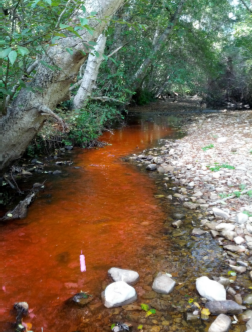
miniDOT Loggers Solve the Case of the Disappearing Jellyfish
December 1, 2020
miniDOT® and miniPAR Loggers Used to Measure Arctic Lake Metabolisms
July 22, 2021Stream-Aquifer Interactions with Coastal California Watershed
Project Details
- PRODUCT(S): Cyclops-7 Logger
- APPLICATION: Source / Raw Water
- PARAMETER: Rhodamine WT Dye
- LOCATION: Scotts Creek
- ORGANIZATION: Department of Natural Resources Management & Environmental Sciences, California Polytechnic State University, San Luis Obispo
- RECOGNITION: Bwalya Malama

Case Study Description
California passed the Sustainable Groundwater Management Act in 2014 to reduce the depletion of surface flows in streams that was occurring due to unsustainable groundwater management practices. A team of researchers recently published the results of their study of stream-aquifer interactions in a watershed along the California coast. The goal of the study was to assess the impact of groundwater pumping for irrigation on stream flows. The researchers used a variety of tools and methods for this study, including PME’s Cyclops-7 Logger.
Location
The study took place at Scotts Creek, a 7800-hectare coastal watershed in Santa Cruz County, CA. Scotts Creek contains a significant population of Coho salmon, an endangered species. The creek is home to other sensitive species as well, including steelhead trout, tidewater gobies, and red-legged frogs. The study itself was conducted in the lower part of the watershed because it has a low surface elevation gradient.
Research Methods and Goals
The researchers used direct-push subsurface sampling, lab analysis of subsurface samples, geophysical resistivity surveys, and pumping tests to understand and characterize the connectivity of the stream to the underlying aquifer.
This was accomplished using direct-push power probes at 18 different sites throughout the lower part of Scotts Creek to measure stratigraphic changes and the particle size distribution of unconsolidated geologic materials that lay on top of the aquifer. The lab analysis of these samples enabled the researchers to estimate the saturated hydraulic conductivity of the sediments.
The geophysical resistivity survey was performed using a SuperSting R8 electrical resistivity meter from AGIUSA at three different spots along Scotts Creek.
Before beginning the pumping tests, dye was injected 24 hours in advance to establish a steady-state background concentration. At this point, tracer concentration and temperature were monitored at five-minute intervals using PME’s Cyclops-7 Logger, which was placed about 200 meters downstream from where the dye was injected. Once the dye injection process was complete, two pumping tests were conducted in two of the agricultural wells used in the study in order to determine the aquifer’s hydraulic properties as well as leakage across the aquitard (a layer below the unconfined aquifer that restricts the flow of groundwater between aquifers) and stream depletion.
Next, the researchers used subsurface piezometers equipped with pressure transducers to passively monitor the long-term groundwater fluctuations in the area. These fluctuations could be caused by a number of things, including evapotranspiration, precipitation, changes in stream flows, and groundwater abstraction (for irrigation purposes). The water levels at 3 of the piezometer sites and three irrigation wells were passively monitored at 15-minute intervals over a span of 18 months. During this time, nearby farmers were asked to continue to go about their work as usual. The goal was to analyze the long-term data of water fluctuations in the stream and aquifer system as a result of groundwater pumping, evapotranspiration, and rainfall.
Conclusion and Results
The results showed that groundwater abstraction for irrigation had little to no effect on the water levels of Scotts Creek. The researchers cautioned, however, that, since this was only a 2-year study, potential longer-term climate changes and water resource needs should be taken into account when deciding on the best groundwater management strategies.
The various testing and measurement methods also provided the scientists with valuable insight into which testing methods were the most accurate for this type of study.
Product Description
The Cyclops-7 Logger connects to one Turner Designs Cyclops-7 sensor. PME offers a fixed sensor version as well as an interchangeable sensor version. The logger records measurements internally at a variety of possible sample rates. Data are offloaded from the logger to a computer via a standard USB cable. The logger is completely self-contained and waterproof. Internal power allows the logger to operate for approximately 28,000 samples.
Contact us to learn how a Cyclops-7 Logger can help you in your next research project.

